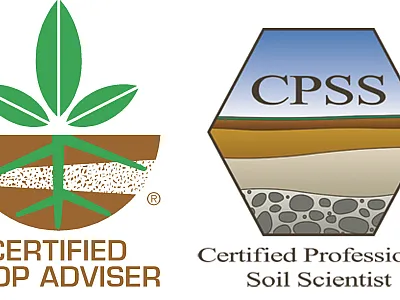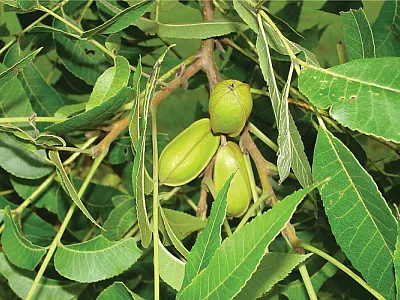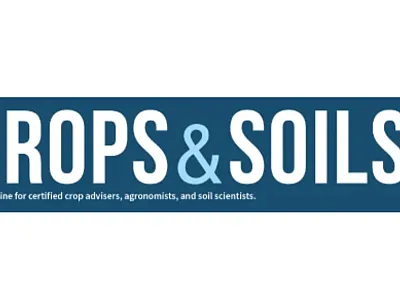4R fertilizer management strategies help tame N2O emissions in Manitoba
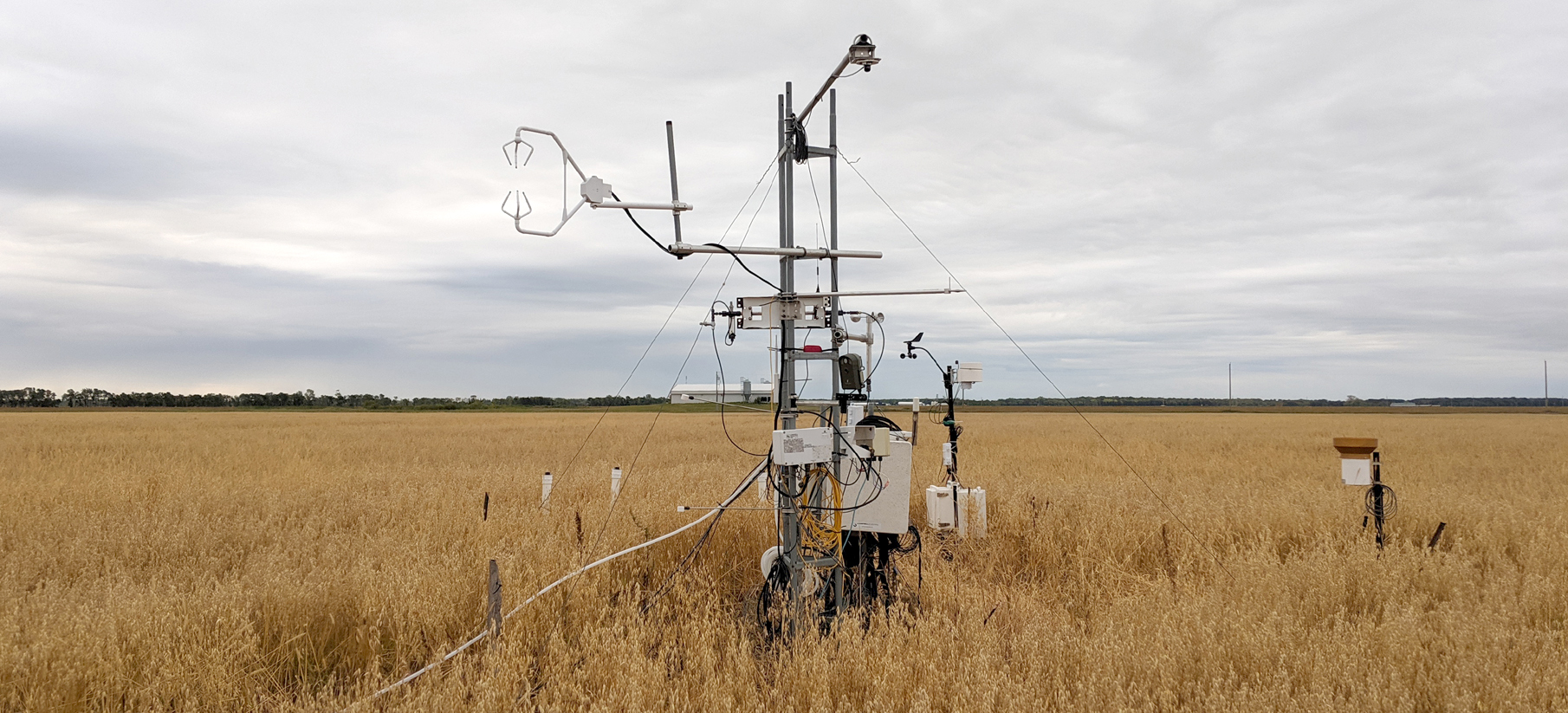

Nitrous oxide (N2O) is recognized as a powerful greenhouse gas. The Canadian government has set a target to reduce N2O emissions from nitrogen fertilizers in soil by 30% by 2030 and is currently offering a number of incentives for mitigating practices. Practices that have been studied and shown to have an impact on N2O include the 4R components rate, source, placement, and timing as well as cropping system factors of rotation with legumes, organic production, and cover cropping. Earn 0.5 CEUs in Nutrient Management by reading this article and taking the quiz at https://web.sciencesocieties.org/Learning-Center/Courses.
Nitrous oxide (N2O) is recognized as a powerful greenhouse gas. Canadian estimates of N2O–N emissions range from 0.1 to 4.1% of applied nitrogen (N) fertilizer with more emissions with increasing annual precipitation. For the country, about 1% of applied fertilizer N is lost at N2O–N. At 1% loss, a 100 lb N/ac application rate, the loss is agronomically insignificant but environmentally consequential since it is equivalent to 462 lb CO2e/ac. The Canadian government has set a target to reduce N2O emissions from fertilizer emissions in soil by 30% by 2030 and is currently offering a number of incentives for mitigating practices.
Over the past decade, many research studies in Manitoba have been conducted to quantify such losses arising from N management and how 4R nutrient stewardship strategies can reduce N2O emissions.
Manitoba is located in the Canadian Prairies with a semi-arid continental climate, average precipitation of 20 inches (20% as snowfall), and an average annual temperature of 2°C (35.6°F). The N2O-N emissions are about 0.4% of applied N. They are less than in more warmer and more humid regions but still need to be minimized. Research has shown the Red River Valley can have considerably more N2O losses because their soils are high in clay and organic matter and are poorly drained.
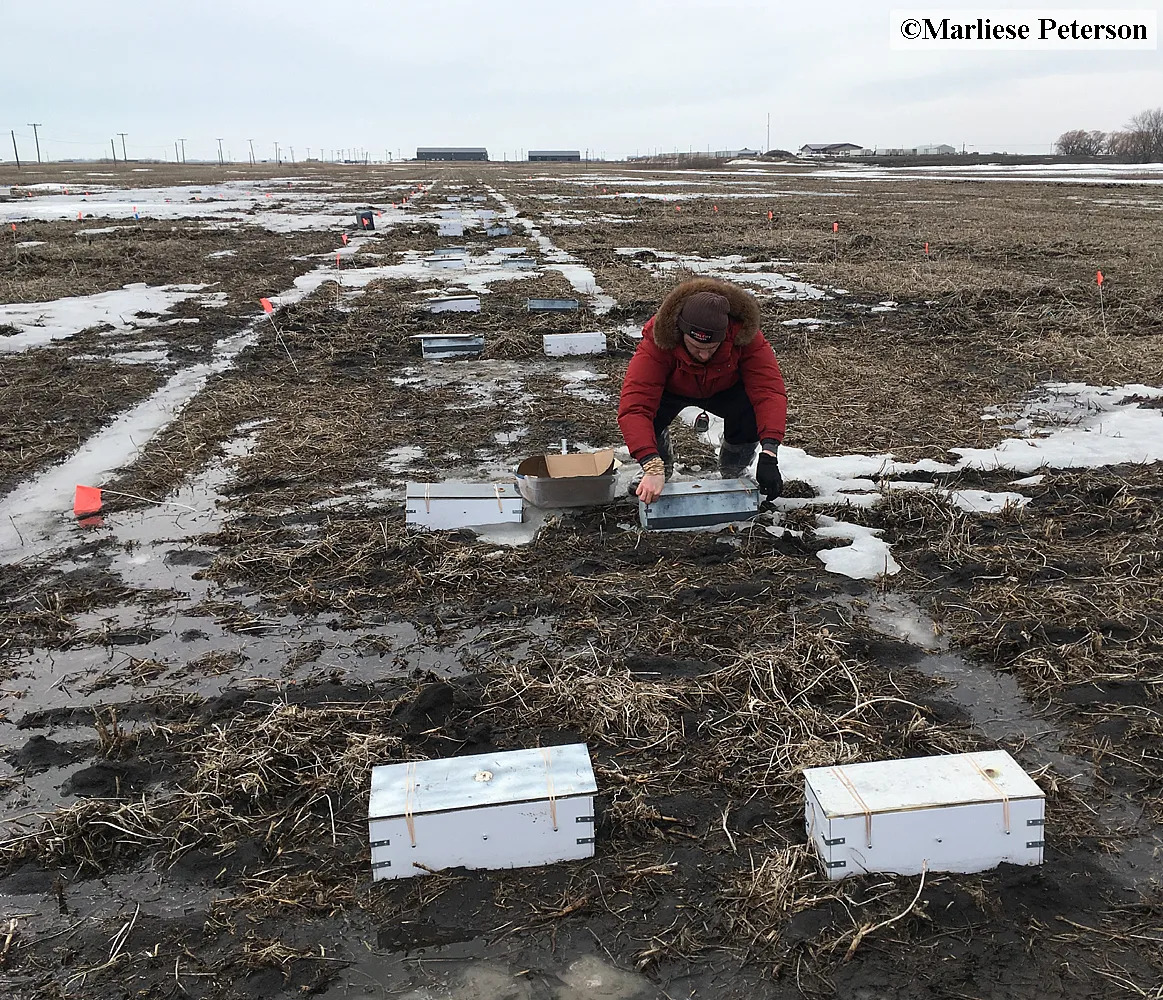
The cause and control of N2O emissions has been measured with two field approaches. Continuous N2O measurement with the flux-gradient technique (Figure 1) at permanent field sites has helped identify the two major episodes when emissions occur. The static vented chamber technique (Figure 2) is used at off-station sites with sampling twice per week, generally amounting to 30 samples over the season. This technique is generally used to assess effectiveness of various management practices.
The continuous measurement technique identified that N2O release occurs in two main episodes in Manitoba (Figure 3): (1) denitrification during spring thaw (usually amounting to 25–35% of cumulative emissions) and (2) one to four weeks after N fertilizer application, coinciding with rainfall events and rapid nitrification through a nitrifier-denitrification process. The process of these losses is shown in Figure 4.
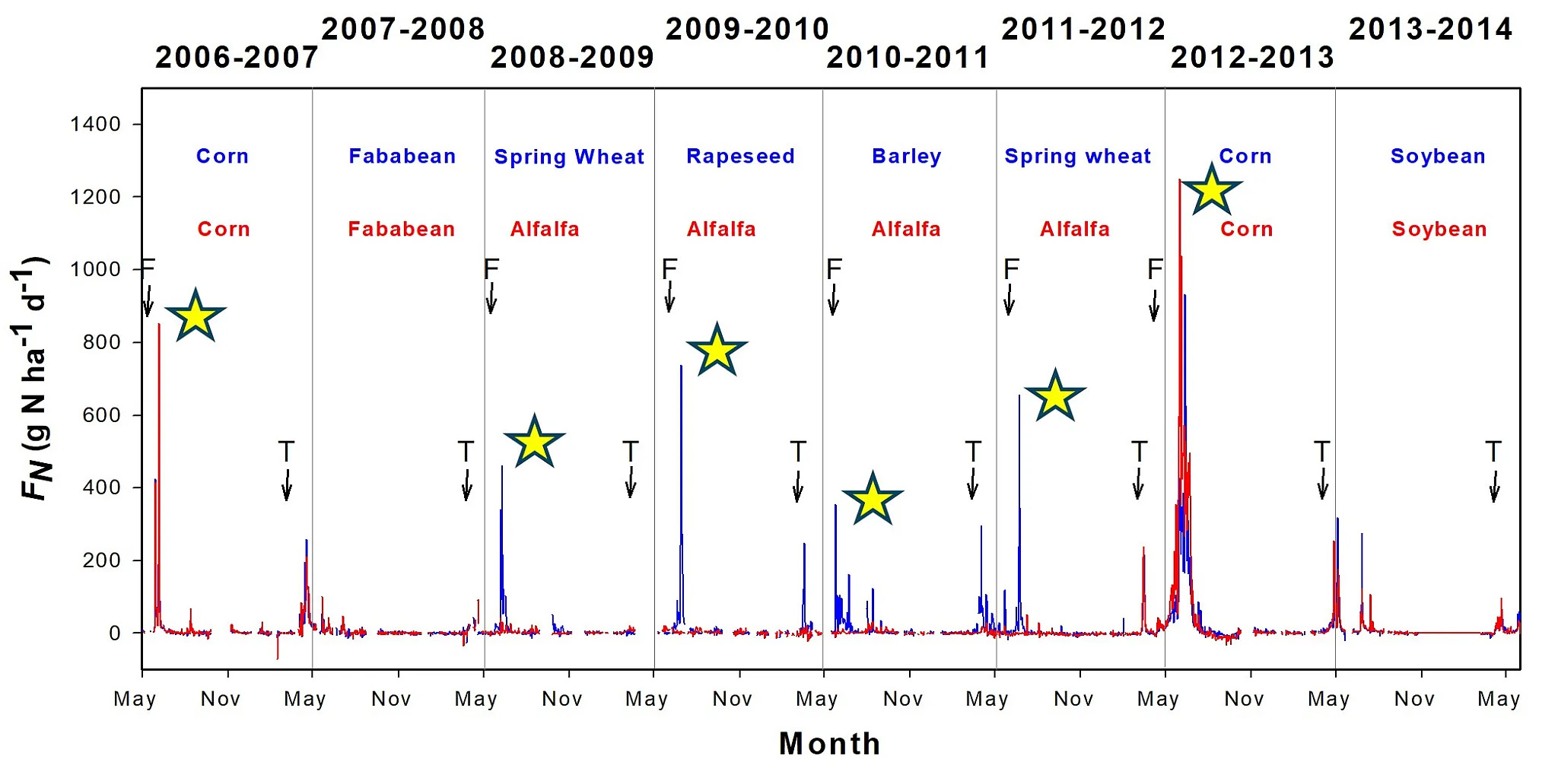
‘Loitering NO3’ and ‘leaky pipe’ N2O losses
Spring thaw denitrification occurs to “loitering nitrate,” that is, nitrate present in the soil when active crop uptake is not occurring. Such “loitering NO3” is vulnerable to denitrification under waterlogging or leaching losses on coarse-textured soils (Figure 4). Our measurements show such loitering nitrate can produce measurable amounts of N2O during the spring thaw but generally not during the growing season. In warmer soils later in the season, nitrate appears to be fully denitrified to N2 gas, which can be a substantial agronomic loss to the farmer, but environmentally benign, just adding to the 70 million lb of N2 gas already above every acre. Such denitrification losses of nitrate-N to N2 on waterlogged Manitoba soils can approach 2–4 lb N/ac/day when soils are cool (5°C or 41°F) and increasing as soils warm.
Denitrification during the nitrification process (Figure 4) is commonly now referred to as a “leaky pipe.” Rapid microbial nitrification of fertilizer N appears to outpace the diffusion of O2, and with scarce O2, nitrifiers reduce some NO2– to N2O. This accounts for 60–65% of N2O emissions in Manitoba soils. Using strategies that slow down this rapid nitrification (such as inhibitors or band application) or reduce the amount of N being nitrified (split applications, controlled release) reduce this escape of N2O.
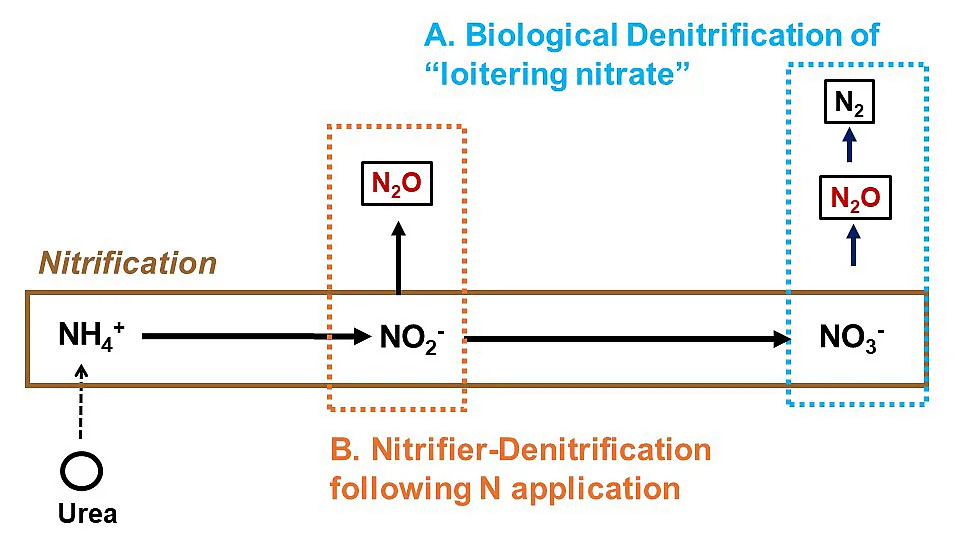
Numerous studies have been conducted to evaluate the effectiveness of 4R nutrient stewardship strategies in addressing these N2O losses from “loitering NO3” and the “leaky pipe” nitrification process. A summary of these studies is presented in Table 1, according to the management practice, showing the average cumulative reductions in N2O and the effect on crop yield compared with a “standard practice” (generally spring-broadcast urea) and the level of confidence that N2O emissions will be reduced. The N2O reductions for nitrogen fertilizer practices are greater if considering only emissions from N fertilizer additions. This is because the background N2O that can occur without the addition of fertilizer is included.
How do 4R practices impact N2O?
Practices that have been studied and shown to have an impact on N2O include the 4R components rate, source, placement, and timing as well as cropping system factors of rotation with legumes, organic production, and cover cropping.
| Table 1. Summary of production practices on N2O emission, crop yields, and confidence of emission reduction. | |||
| Management practice | N2O reduction | Yield impact | Confidence (no. of site-years) |
| ─────────%───────── | |||
| SOURCE | |||
| Polymer-coated urea (ESN) | 23 | 2 | High (23)a |
| Nitrification inhibitors | 32 | -1 | High (32) b |
| TIMING | |||
| Split N application | 48 | -2 | Moderate (13) c |
| -fall application | Increase 36 | -1 | Moderate (7) d |
| PLACEMENT | |||
Banding depth—deep (>2 inches)
| 3 | -1 | Low (16) e
|
| Banding depth—shallow (<2 inches) | Increase 89 | -5 | Low (6) |
| RATE | |||
| Variable rate | yes | + | Low (3) f |
| CROPPING SYSTEM | |||
| N-fixing legumes | 61 | NA | High (15) g |
| Organic production | 17 | -32 | Low (2) h |
| Cover crop | 1 | Low (4) | |
a Asgedom et al. (2014), Gao et al. (2015, 2017), Oleson et al. (unpublished), and Wood (2018).
b Gao et al. (2015), Tenuta (unpublished), and Wood (2018).
c Gao et al. (2017), Oleson et al. (unpublished), and Tenuta (unpublished).
d Tenuta et al. (2016) and Wood (2018).
e Gao et al. (2015, 2017) and Wood (2018).
f Glenn et al. (2021).
g Tenuta et al. (2019), Tenuta (unpublished), and Westphal et al. (2018).
h Tenuta et al. (2019).
Source
Use of polymer-coated urea and nitrification inhibitors (collectively called enhanced-efficiency fertilizers) can generally achieve the 30% N2O emission reduction target. However, incentives may be necessary since yield responses are rare in Manitoba studies and products are more costly. Currently about 15% of Prairie wheat and canola growers use polymer-coated N or nitrification inhibitors (according to the 2023 Western Canada Fertilizer Use Survey).
Timing
Split applications of N fertilizer, with some placed before or near seeding and the remainder during the growing season, significantly reduced emissions. This may be a suitable strategy for long-season crops or those with delayed N uptake, such as corn and potato. Canola and cereals may also be considered for split application, but current adoption is low (<3% growers) since typically dry summer conditions risk yield loss by stranding surface nitrogen fertilizer applications.
Fall application of N fertilizer is a common practice in Manitoba; it’s typically used by 40% of growers depending on fall weather and soil conditions. Strategies that reduce fall nitrification to “loitering nitrate” include applying in a band, using an ammonium-N form, delaying application until soils have cooled below 10°C (50°F), and using an enhanced-efficiency fertilizer, such as one with controlled release or with a nitrification inhibitor (Figure 5). In those study sites where fall applications of N fertilizer did convert to nitrate, high N2O emissions occurred during thaw the next spring, particularly on saturated clay soils.
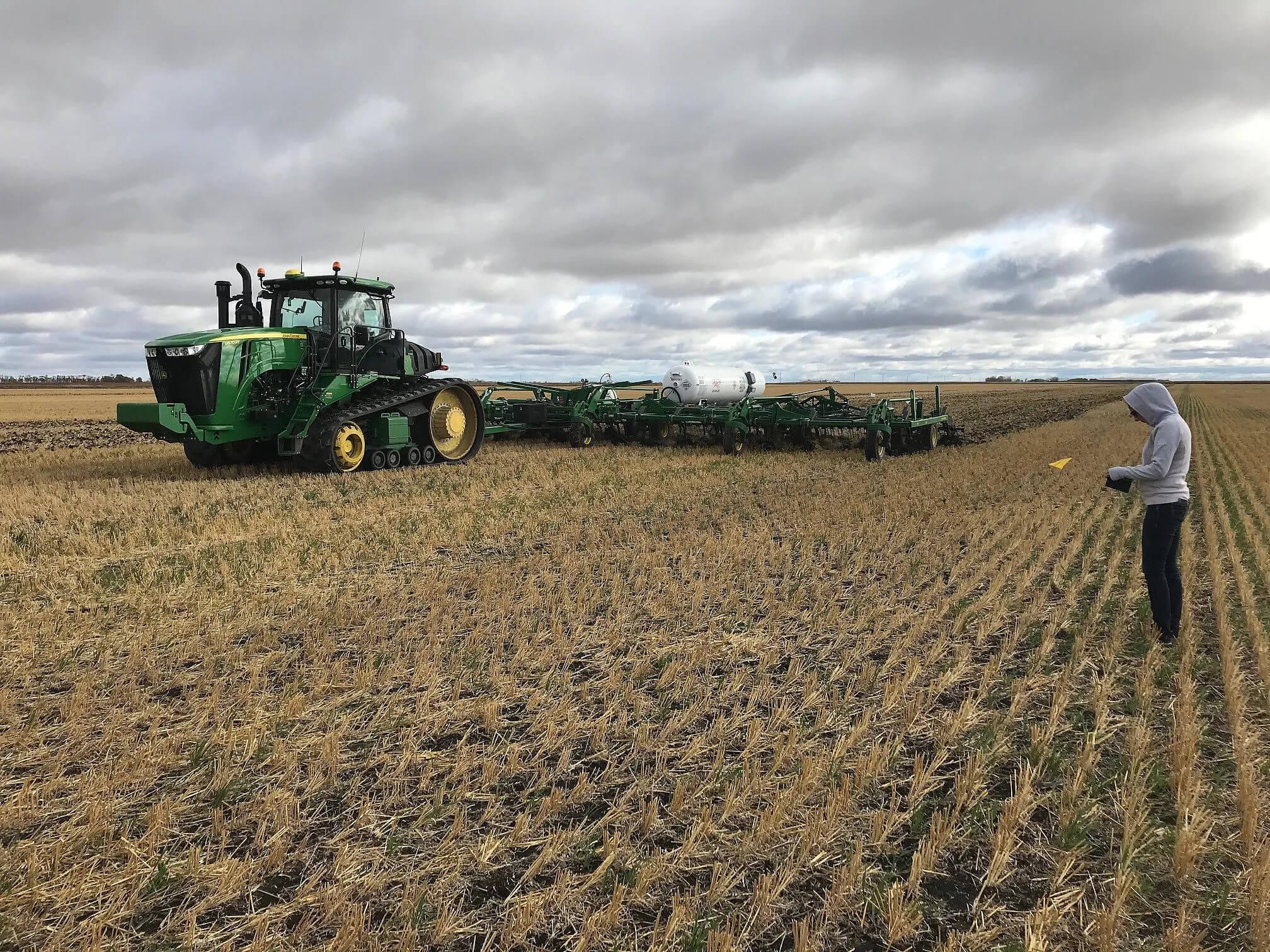
Placement
Traditional Manitoba studies have shown 20% greater efficiency with in-soil N banding than broadcast-incorporated, indicating broadcast rates may need to be 20% greater to achieve similar yield. This efficiency is partly due to the slowing of nitrification in a concentrated fertilizer band. Banding of nitrogen is a popular practice by Prairie farmers. The percent of Prairie canola and wheat acres with banded N are as follows: 12% were fall-banded, 3.5% preplant-banded in the spring, and 40% side-banded (Figure 6) and 37% midrow-banded while seeding.

The N efficiency from banding could be a direct reduction in N2O emissions if application rates were decreased accordingly, but in these reported studies, similar N rates were applied. Emission results of N2O were variable with deep-banding N across a number of crops and placements.
Shallow side-banding of N is common when seeding small-seeded crops such as canola, but it was seen to increase N2O emissions and should be avoided.
Rate
Emissions of N2O are generally proportional to N fertilizer application rates. Practices such as fall soil nitrate sampling to 24 inches and selection of appropriate yield goals help farmers select appropriate fertilizer rates. Variable-rate N application has been adopted by less than 15% of farmers. A single study of variable-rate N application found high-yielding zones had the lowest N2O emission levels despite receiving more fertilizer than the field average compared with lower-producing zones, primarily in areas with poor drainage. Further studies have been initiated to study variable-rate and targeted application of inhibitors in zones with greater risk of N loss.
Rotation with legumes
Nitrogen-fixing legumes such as alfalfa, soybean, faba bean, and field pea emit very little N2O above what would occur without N fertilizer application. About a third of Manitoba wheat and canola growers often follow a N-fixing crop such as soybeans or field peas.
Organic production, cover crops
Organic production can result in a modest decrease in N2O emissions; however, yields are substantially lower. These organic yields will need to be increased if this system is to reduce emission for the same amount of food produced using conventional methods. High N2O emissions were measured at sites when tilled green manure or perennial alfalfa left high levels of overwintering loitering nitrate (Figure 7), which can result in large spring-thaw emissions of N2O if soils come into winter saturated with water. Cover crops that over-winter such as fall rye did not increase N2O emissions. Cover crops that winter-kill such as tillage radish or red clover seem to slightly increase emissions, though more studies are needed. To what extent any of the covers increase soil C capture on the Prairies is not yet known.
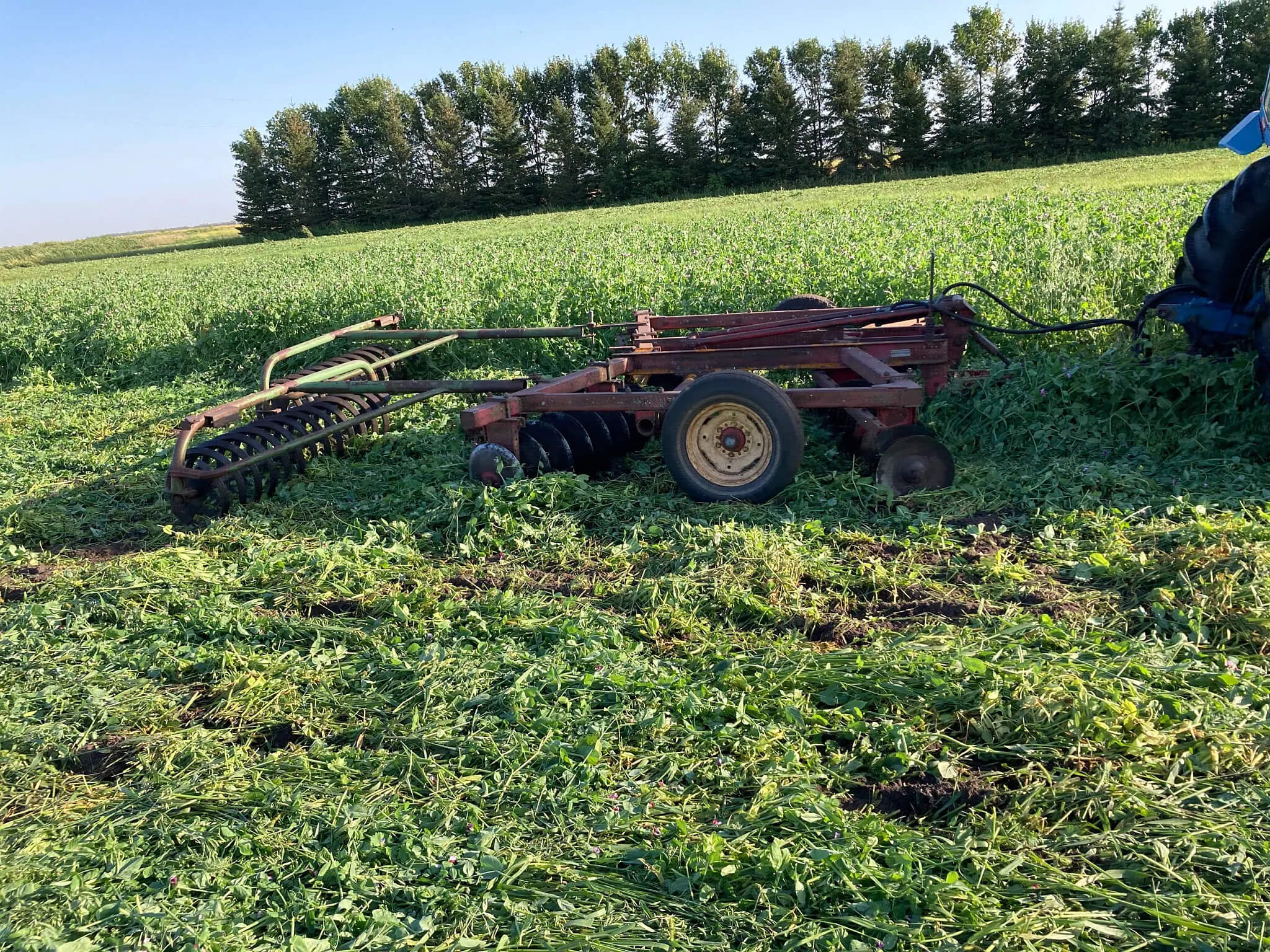
There is great promise shown by using 4R practices, either alone or in combination, to reduce N2O emissions. Some of these practices, such as banding N, are well established as agronomically superior to broadcast N fertilizer and are highly adopted by farmers. But practices such as use of nitrification inhibitors or cover cropping are rarely justified through increased yield, so financial incentives are being offered by the federal government to encourage their adoption. It is important for the adviser to consider changing the rate of fertilizer N with better 4R practices. Consider if reductions in losses of N from leaching, volatilization, denitrification, and N2O can afford a reduction in rate. This can offset the added costs of 4R practices.
References
Asgedom, H., Tenuta, M., Flaten, D.N., Gao, X. & Kebreab, E. (2014). Nitrous oxide emissions from a clay soil receiving granular urea formulations and dairy manure. Agronomy Journal, 1106, 732–744.
Gao, X., Asgedom, H., Tenuta, M. & Flaten, D.N. (2015). Enhanced efficiency urea sources and placement effects on nitrous oxide emissions. Agronomy Journal, 107, 265–277.
Gao, X., Tenuta, M., Parsonage, S., Baron, K., Hanis-Gervais, K., Nelson, A., Tomasiewicz, D. & Mohr, R. (2017). Nitrogen fertilizer management practices to reduce N2O emissions from irrigated processing potato in Manitoba. American Journal of Potato Research, 94, 390–402.
Glenn, A., Moulin A., Roy, A., & Wilson H. (2021). Soil nitrous oxide emissions from no-till canola production under variable rate nitrogen fertilizer management. Geoderma, 385, 114857.
Tenuta, M., Gao, X., Flaten, D.N. & Amiro, B.D. (2016). Lower nitrous oxide emissions from anhydrous ammonia application prior to soil freezing in late fall than spring pre-plant application. Journal of Environmental Quality, 45(4), 1135–1143.
Tenuta, M., Amiro, B., Gao, X., Wagner-Riddle, C. & Gervais, M. (2019). Agricultural management practices and environmental drivers of nitrous oxide emissions over a decade for an annual and an annual-perennial crop rotation. Agricultural and Forest Meteorology,276–277, 107636
Westphal, M., Tenuta, M. & Entz, M.H. (2018). Nitrous oxide emissions with organic crop production depends on fall soil moisture. Agriculture, Ecosystems and Environment, 254, 41–49.
Wood, M. (2018). Right source and right time: Reducing nitrous oxide emissions with enhanced efficiency nitrogen fertilizers [M.Sc. thesis, University of Manitoba]. https://mspace.lib.umanitoba.ca/items/6a0551f2-4490-4573-becf-4060de6f3929
Self-Study CEU Quiz
Earn 0.5 CEU in Nutrient Management by taking the quiz for the article at https://web.sciencesocieties.org/Learning-Center/Courses. For your convenience, the quiz is printed below. The CEU can be purchased individually, or you can access as part of your Online Classroom Subscription.
- Emissions of N2O-N are about ___% of applied nitrogen (N) fertilizer.
- 3
- 13
- 0.1
- 1
- What is “loitering nitrate”?
- Nitrate emitted under warm and humid conditions.
- Nitrate emitted under cold and dry conditions.
- Nitrate present in fertilizer.
- Nitrate present in the soil when active crop uptake is not occurring.
- Which of the following is a strategy that can be used to reduce the rate of fertilizer N being nitrified?
- Late fall application.
- Controlled release.
- Band application.
- All of the above.
- Which of the following management practices did NOT produce a reduction in N2O emissions, as shown in Table 1?
- Shallow side banding.
- N fixing legumes.
- Split N application.
- Polymer-coated urea.
- Alfalfa, field pea, and faba bean all emit very little N2O over what would occur without N fertilizer application.
- True.
- False.
Text © const today = new Date();const year = today.getFullYear(); document.currentScript.insertAdjacentHTML('beforebegin', year);. The authors. CC BY-NC-ND 4.0. Except where otherwise noted, images are subject to copyright. Any reuse without express permission from the copyright owner is prohibited.


